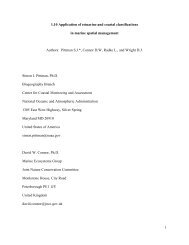Seamounts, Ridges, and Reef Habitats of American Samoa
Seamounts, Ridges, and Reef Habitats of American Samoa
Seamounts, Ridges, and Reef Habitats of American Samoa
- No tags were found...
Create successful ePaper yourself
Turn your PDF publications into a flip-book with our unique Google optimized e-Paper software.
<strong>Seamounts</strong>, <strong>Ridges</strong>, <strong>and</strong> <strong>Reef</strong> <strong>Habitats</strong> <strong>of</strong> <strong>American</strong> <strong>Samoa</strong> 801open slopes dominate, which further descend toward the broad depressions with openbottoms (Figure 58.8A). Open slopes above <strong>and</strong> on the edge <strong>of</strong> the narrow depressionsin the center <strong>of</strong> the bay suggest prior seafloor subsidence, resulting also in anoteworthy ridge at the east center <strong>of</strong> the bay (~14°221S, 170°4552W; Figure58.8B). It is classified as a narrow crest with fringing lateral mid-slope crests <strong>and</strong>depressions. The edge <strong>of</strong> the narrow crest deepens so dramatically in some placesthat there is a narrow str<strong>and</strong> <strong>of</strong> steep slopes around it. Steep slopes are also seen atthe edge <strong>of</strong> other narrow crests <strong>and</strong> lateral mid-slope features throughout the bay. Thearea that appears most complex, containing a diverse combination <strong>of</strong> BPI zones, aswell as high to medium-high rugosity, is in the southeast portion <strong>of</strong> the bay, whichextends to depths safe enough for submersible observations. Submersible observationson Dive P5–649 visually confirmed the presence <strong>of</strong> narrow mid-slope depressions<strong>and</strong> lateral mid-slope crests, while noting also the presence <strong>of</strong> several small boxcanyons cut into the southeast wall that were not detected in the original terrain classification.Of note also is a transition at ~185–209 m depth from old carbonate reef toa basalt layer, <strong>and</strong> another carbonate layer before transitioning to sediment at ~235 m.s0025p0130p0135p0140Biological CommunitiesPisces V submersible Dive P5–648 consisted <strong>of</strong> a video <strong>and</strong> photographic survey upthe southwest wall <strong>of</strong> Taema Bank, noting 36 m as the depth at which the main coralsextend to (base <strong>of</strong> main reef on bank) on a fairly consistent basis. It then proceededto a deeper, safer contour <strong>of</strong> interest for sub/ships operations (down to 110 m, belowsignificant surface wave surge), following it to the east along the south side <strong>of</strong> thebank, making observations <strong>of</strong> biota <strong>and</strong> physical structure.The dive followed the 110 m depth contour for ~7 km in the broad depression/openbottom habitat class, <strong>and</strong> noted a significant assemblages <strong>of</strong> gorgoniancorals (Iciligorgia), sea fans (e.g., Annella reticulata, Melithaea), whip corals(Cirrhipathes), <strong>and</strong> sea cucumbers (Holothuria edulus, Thelonota anax). A transitionwas noted from west to east <strong>of</strong> sea fans in the east having crinoids attached to theirtops, <strong>and</strong> with three-armed, feathery brittlestars. There were also alternating “provinces”<strong>of</strong> barren, sloping calcareous (Halimeda) algae, s<strong>and</strong> plains, to slopes cut bydeep crevices in calcareous conglomerate blocks to sea fans assemblages. In thissame habitat class, various species <strong>of</strong> groundfish (e.g., greeneye or Chlorophthalmuspriridens, orange sea toad or Chaunax fimbriatus, <strong>and</strong> the black-botched stingray orTaeniura meyeni; Figure 58.9) congregated in high rugosity, carbonate rubble piles,which may have been created by the fish as habitat.Dive P5–649 consisted <strong>of</strong> a video <strong>and</strong> photographic survey around the edge <strong>of</strong>Fagatele Bay <strong>and</strong> Canyon, starting from the southwest corner <strong>and</strong> reaching the far southeastportion <strong>of</strong> the national marine sanctuary. Most <strong>of</strong> the dive scaled both southwest<strong>and</strong> southeast walls <strong>of</strong> the bay <strong>and</strong> canyon; hence, the predominant habitat classes werenarrow (vertical) depression <strong>and</strong> lateral mid-slope crest. Main species observed includedthe harlequin grouper (Cephalopholis; Figure 58.9), the bigeye (Heteropriacanthus cruentatus),sea fans (Annella reticulata), gorgonian corals (Iciligorgia), <strong>and</strong> “doughboy”
















